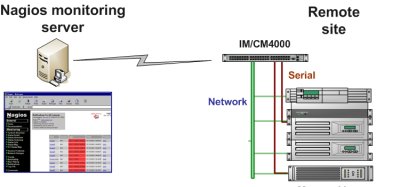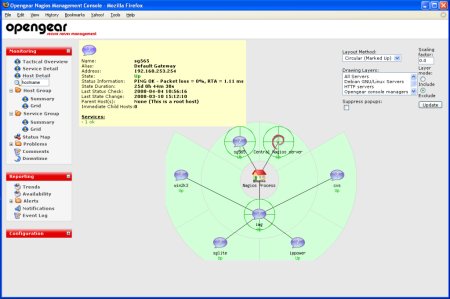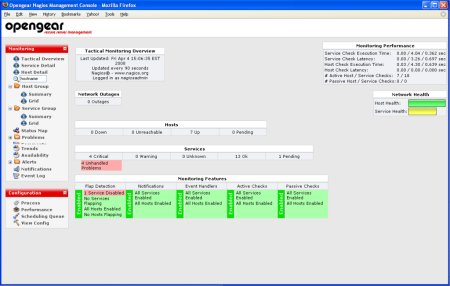Linux-based remote access equipment adds monitoring
May 14, 2008 — by Eric Brown — from the LinuxDevices Archive — 2 views Opengear is integrating the popular Nagios open-source network and device monitoring software in its open-source, uClinux-based remote access equipment. Opengear's SDT (“secure desktop tunneling”) for Nagios product combines its SDT Connector remote access client software with Nagios… central management software.
Opengear is integrating the popular Nagios open-source network and device monitoring software in its open-source, uClinux-based remote access equipment. Opengear's SDT (“secure desktop tunneling”) for Nagios product combines its SDT Connector remote access client software with Nagios… central management software.
The announcement follows up on Opengear's February 2007 announcement that the company had integrated components of Nagios software into its IM4200 gateways (pictured below, at right) and CM4000 console servers (pictured above). With the SDT for Nagios product, Nagios monitoring is now extended to be available within Opengear's overall out-of-band management system, providing “centralized monitoring of all the computers, software and network services in complex and geographically dispersed data center,” says the company.
 Opengear's IM4200 gateway |
SDT for Nagios integrates Nagios with Opengear's SDT Connector management software and CM4000 console servers, providing network operations center and data center administrators with both in-band and out-of-band remote access. The new software is also said to provide control of all physical and virtual ICT assets from a single Nagios screen. Nagios monitors networks, servers, and applications, says Opengear, and then provides alarming and notification mechanisms, as well as escalation rules to alert administrators of potential problems. Once the notification has been sent, the SDT for Nagios management software provides automated secure access to the problem location, and provisions the necessary tools for resolving the incident.

SDT for Nagios in action
Dedicated Nagios slave servers are often not required at remote sites, says the company, because Opengear console servers and gateways embed Nagios NSCA (Nagios service check acceptor) client software and NRPE (Nagios remote plugin executor) server software, which enables them to function as distributed Nagios monitoring servers. Nagios provides real-time status for each host, network node, and service, displaying warnings and raising alarms when a service failure is detected.

SDT for Nagios status map, showing hosts being monitored
(including serially and LAN connected hosts)
(Click to enlarge)
Nagios comes standard with hundreds of plugins, including those that test response times for network services based on protocols such as http, nntp, smb, and many, many others. Users can also easily write and schedule custom system and network tests — for example, to make sure that databases have not crashed. If responses fall outside of configurable ranges, alarms can be sent to pagers, email accounts, or phone gateways.

SDT for Nagios tactical overview (green boxes indicate “OK” operation).
(Click to enlarge)
Opengear was founded three years ago by uClinux pioneer Bob Waldie, with the aim of using open-source software to reduce the cost of remote access and network center management equipment. Its IM4200 gateways and CM4000 console servers aim to offer secure, remote, in-band access based on VNC and RDP tunneled through SSL, an approach said to cost less and be easier for users than enterprise-wide VPN gateways. The devices also offer out-of-band management, for instance enabling users to remote reboot crashed servers without involving hosting provider staff.
According to Waldie, Nagios was selected both for its quality and its open source, GPL licensing. He wrote in an email, “I think it is good sign to see low level embedded Linux appliance vendors (like Opengear) connect with the user level application solution providers like Nagios. Who knows where this will lead? Asterisk + Android??? Sugar + Mozilla???”
Availability
SDT for Nagios is available now for free download. Nagios management software and Opengear's SDT extensions can be downloaded and run free of charge. Both Nagios and the SDT plug-ins are open source and licensed under the GNU Public License (GPL v2). More information may be found here.
This article was originally published on LinuxDevices.com and has been donated to the open source community by QuinStreet Inc. Please visit LinuxToday.com for up-to-date news and articles about Linux and open source.